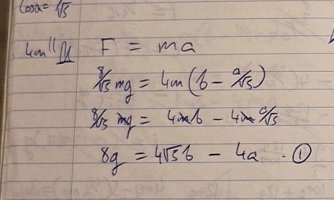No way ! ... I will be home later and post old fashioned pen + paper photos of my solution..Then, you are smarter than me. But my method of calculation has a benefit that yours might not have. I will tell you about it later. For now, let us see how you did it!
You are using an out of date browser. It may not display this or other websites correctly.
You should upgrade or use an alternative browser.
You should upgrade or use an alternative browser.
Can anyone see where I go wrong (applied maths question...)
- Thread starter pazzy78
- Start date
Very impressive! But before we jump and make any conclusions, let us analyze your calculations and see if they are correct or you just got lucky to get the required result (with wrong calculations).
I will start with this fragment:

It is clearly you have shown here that a component of the gravity force with an acceleration [imath](b)[/imath] is pulling the particle down the slope of the wedge. In the same time, you are saying that there is a component of the wedge acceleration [imath](a)[/imath] is going in the opposite direction of [imath](b)[/imath]. Correct me if I am wrong.
But the wedge does not have any component of acceleration in the slope direction. Its acceleration vector is completely pointing to the right as you have shown in post #22.
What is your comment about this?
I will start with this fragment:

It is clearly you have shown here that a component of the gravity force with an acceleration [imath](b)[/imath] is pulling the particle down the slope of the wedge. In the same time, you are saying that there is a component of the wedge acceleration [imath](a)[/imath] is going in the opposite direction of [imath](b)[/imath]. Correct me if I am wrong.
But the wedge does not have any component of acceleration in the slope direction. Its acceleration vector is completely pointing to the right as you have shown in post #22.
What is your comment about this?
hmmm not sure, I think i have accounted for the acceleration in the slope direction ...
see red circles...
Also I did another problem that was similar but different masses, angles etc ... and using the same method got the right answer
So maybe for 1 question to get it right by chance - but 2 ??? - no way...

see red circles...
Also I did another problem that was similar but different masses, angles etc ... and using the same method got the right answer
So maybe for 1 question to get it right by chance - but 2 ??? - no way...

I have told you before that you are smarter than me. I have dug deeply into your calculations and diagrams and I have discovered that you are calculating the acceleration of the particle with respect to the ground, not in the horizontal and vertical directions, but rather in the slope direction which is so peculiar.
Your calculations are correct and fancy because they give a big shortcut to find the acceleration of the wedge without dealing with the acceleration of the particle.
It is always a good strategy to be able to solve the same problem in two different ways. Therefore, it will not be a waste of time if you spend a little time in understanding my method because it is the standard way to solve such ramps.
Your calculations are correct and fancy because they give a big shortcut to find the acceleration of the wedge without dealing with the acceleration of the particle.
What I wanted to tell you back (the benefit) in my post #20 was that my calculation could derive the general formula of the acceleration of the wedge. And it seems that your method does derive it as well.Then, you are smarter than me. But my method of calculation has a benefit that yours might not have. I will tell you about it later. For now, let us see how you did it!
It is always a good strategy to be able to solve the same problem in two different ways. Therefore, it will not be a waste of time if you spend a little time in understanding my method because it is the standard way to solve such ramps.

